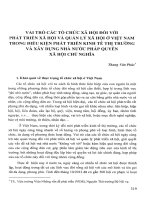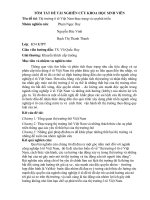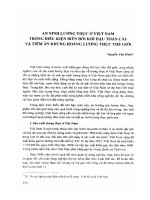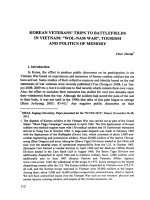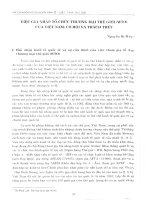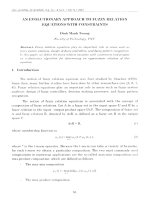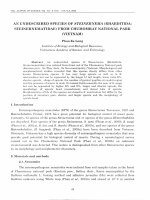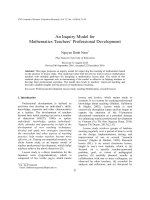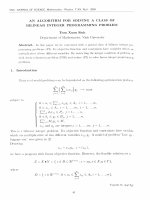DSpace at VNU: An evolutionary approach to fuzzy relation equations with constraints
Bạn đang xem bản rút gọn của tài liệu. Xem và tải ngay bản đầy đủ của tài liệu tại đây (916.29 KB, 7 trang )
yNU JOURNAL QF SCIENCE, Nat Sa ■& Tech , T XIX, Npl. 2003______________________________________
AN E V O L Ư T Ĩ O N A R Y A P P R O A C H T O FUZZY R E L A T I O N
E Q U A T I O N S WITH C O N S T R A I N T S
D in h M a n h T u o n g
F n i ' u ì t y n f T c c h TìCìlogy, V N l ĩ
Á b str a ct. Fưzzy rclation cquations plaỵ an ìmỊTortant rolc in arcas stjch CIS
fu z z v sy ste m a n a ly sis, dcsÌỊỊn o f fu z z y co ntrolỉers, a n d f u z z V p a tte r n rcco g n itio n
hì th is paper, ICC dcfinc thc fu z z y rclation cquation ivith constraints a n d proposc
an c v o lu tio n a r y a lg o r ith m fo r d e tc rm in in g a n a p p r o x im a tc s o lu tio n of th is
cq u a tỉo n
1. I n tr o d u c t i o n
T he n o tio n of fu zzy r e la t io n e q u a tio n w a s íìr st stu died by S a n c h e z (1 97 6).
S in c e th en , m a n y íu r th e r s t u d i e s h a v e been do n e by o th e r r e s e a r c h e r s (se c [õ, 6 , 7,
8 ]). Fuzzv r e la tio n e q u a t io n s play an im p ortan t role in a r e a s su c h a s fu zzy s y s te m
a n a ly s is , d e s ig n o f fu zzy c o n tr o lle r s , d ecision m a k in g p r o c e s s e s , a n d fu zzv p a tte r n
reco g n itio n .
T he
n otio n o f fu zz y r e la tio n e q u a tio n s is a s s o c ia t e d w ith
th e c o n c e p t o f
c.omposition o f fuzzy r e la tio n s . L et A be a fuzzy s e t in t h e in p u t s p a c e ư
a n d R be a
fuzzy r ela tion in th e in p u t - o u t p u t product s p a c e U xV . T h e c o m p o s itio n o f fuzzy se t
A and fuzzv r e la tio n R, d e n o t e d by AoR, is d e fin e d a s a fu zz y s e t B in th e o u tp u t
sp a c e V.
AoR = B,
(1)
HH(y) = max|iA( x ) * n R( x ,y ) ,
x«-u
(2 )
w h o s e m e m b er sh ip fu n c tio n is
w h e r e * is th e t-norm o p era to r. B e c a u s e th e t-n o rm c a n t a k e a v a r ie t y o f ĩo r m u la s,
for each t-norm w e o b ta in a p a r tic u la r c c m p o sitio n . T h e tw o m o s t c o m m o n ly usecỉ
c o m p o sitio n s in n u m e r o u s a p p lic a tio n s are th e so -c a lle d m a x -m in c o m p o s itio n and
m a x - p r o d u c t comỊ)osition, w h ic h a r e de fined as follows:
T h e m a x -m in c o m p o s itio n
Ị.iB ( y ) = m a x m i n | n A ( \ ) . ^ K ( x . y ) l
XkV
T h e m a x -p ro d u ct c o m p o s itio n
D in h M a n h Tuong
56
Htì (y) = max
X €Ư
( x )n R(*. y) •
T he e q u a t io n A o R = B is a so -ca lled fuzzy r e la t io n s e q u a t io n . I f we v iew R
as a fu zzy s y s t e m , t h e n g iv e n a fuzzy s e t A to a fuzzy system R, we can com pute the
systerrTs o u tp u t B by (2). T h e tw o b asis problem s c o n c e r n in g th e fu z z y rela tio n
e q u a tio n are as follow s:
Problem Pl: Given the input fuzzy set A in u and the output fuzzy set B in
V, determine the fuzzy relation R such th a t A o R = B.
Problem P2: Given the fuzzy relation R and the output B, determine the
in p u t A su c h t h a t A o R = B.
T h ereío re, s o lv in g t h e fu zz y rela tio n e q u a tio n A o R = B m e a n s s o lv in g th e
a b o v e tvvo p r o b le m s. In t h is p a p er we are only in t e r e s t e d in t h e p rob lem P l . Sin ce
th e s o lu tio n s for t h e p r o b le m P l m a y not e x ist, w e íìr s t n e e d to c h eck t h e so lv a b ility
o f t h e s e e q u a tio n s or t h e e x is t e n c e o f th eir so lu tio n s.
T h e o re m 1.1. Problem P l has solutions if and only if the height of the fuzzy
set A is greater th an or equal to the height of the fuzzy set B, th a t is
supnA(x) ^ ^ B(x)
for all y eB.
T h e proof o f t h is t h e o r e m c a n s e e in [2].
In order to s o lv e p ro b le m P l , one introduces the cp-operator. The (p-operator
is a n op erator cp: [0,1] X [0,1] -> [0,1] d e íìn e d by
acpb = sup {: € | 0,1 ||a • c £ b
vvhere * d e n o te s t-n o r m o p e r a to r .
If th e t-n orm o p e r a to r is sp ecified as m in im u m , the (p-operator becomes the
so -c a lle d a-o p era tor:
if
if
For fu zzy s e t s A in
u
a < b
a > b
a n d B in V, u s in g t h e cp-operator w e c a n d efin e th e
fu zzy rela tion R* in U x V w h ic h is defin ed as
H r (x*y) = ^ A( x ) W B( y) We d e n o te t h is fu z z y r e la tio n by A(pB.
T he íbllovving t h e o r e m is d e m o n str a te d (se e [2,3]).
An Evolutionary Approach To Fuzzy Rclation Equations .
57
T h e o re n i 1.2. If the solution of problem P l exists, then the largest R (in the
sense of fuzzy set theoretic inclusion) th a t satisĩies the fuzzy relation equation AoR
= B is R* = AọB.
Hovvever, in m a n y c a s e s , an ex a ct s o lu tio n o f problem P l m ay not e x ist.
T h e re ío r e, R* = A(pB m a y n o t bc so lu tio n . If an e x a c t s o lu tio n d o e s not e x ist, w h a t
w e can do is to d e te r m in e a p p r o x im a te s o lu tio n s. W a n g L. X. proposed th e m e th o d
o f d e te r m in in g a p p r o x im a te s o lu tio n th rou gh n e u r a l netvvork tr a in in g (se e [ 1 0 ]).
T h e íu r th e r d e ta ils o f fu zzy rela tio n e q u a t io n s c a n be found in [2, 3].
2.
F u z z y r e la t io n e q u a t io n s w ith c o n s t r a in t s
The
a p p r o x im a te
g e n e r a liz e d
M odus
r e a s o n in g
P o n e n s.
T h is
in
fuzzy
system s
in fer e n c e
r u le
is
states
b a sed
on
th a t
g iv e n
th e
r u le
of
tvvo fu zzy
p ro p o sitio n s “if X is A t h e n y is B ” and “x is A ”’ w e s h o u ld infer a n e w p r o p o sitio n “y
is B m such t h a t t h e c lo se r th e A' to A, th e c lo se r th e B* to B, vvhere A an d A ’ are
fuzzy s e t s in sp a c e u , B a n d B ’ a re fuzzy s e ts in sp a c e V. T h e fu zzy p r o p o sitio n “if X
is A th e n y is B” is in t e r p r e te d as a fuzzy r e la tio n R in U x V . T he fu zzy s e t B ’ in th e
c o n c lu s io n o f g e n e r a liz e d M o d u s P o n en s rule is d e t e r m in e d as B ’ = A ’ o R. In th e
lite r a tu r e , m a n y d iffe r e n t in te r p r e ta tio n s of fu zzy if-th e n ru les are proposed, for
e x a m p le , L u k a s ie w ic z im p lic a tio n , Zadeh im p lic a tio n , M a m d a n i im p lic a tio n , etc.
W e w ish d e te r m in e th e fuzz rela tio n R in te r p r e tin g fu zzy p r o p o sitio n “if X is A th e n
y is B" such t h a t th e c lo se r th e A ’ to A, th e c lo se r th e B ’ = A ’ o K to B.
T h e notion o f fu zzy r e la tio n eq u a tio n vvith c o n s t r a in t s is s t a t e d as follow s.
G iv e n th e fuzzy s e t s A a n d A, (i = 1, ...,k ) in sp a c e ư a n d th e fuzzy s e t B in s p a c e V,
w e s h o u ld d e te r m in e a fuzzy r e la tio n R* in p rod u ct U x V such t h a t t h e fo llo w in g
r e q u ir e m e n ts are sa tisfie d :
A o R* = B.
(3)
If w e d e n o te A, o R* = B, (i = 1 ,..., k) th e n
d(Bif B) = a d(A„ A),
(4)
w h e r e a is c o n s ta n t, a > 0 , an d d(.,.) is th e d is ta n c e b e t w e e n fuzzy s e t s . T he d is ta n c e
d(C, D) b e tw e e n th e fu zz y s e t c and th e fuzzy s e t D 19 d e ĩin e d as follow s
d(C, D) = (f ||IC(x) - ^1 D(y)|r dx ) p ,
pỉl.
For p = 1 o n e h a s th e H a m m in g d is ta n c e an d p = 2 y ie ld s th e E u c lid e a n
d ista n c e . In th e c a s e s th e sp a c e u is fin ite w e c a n s im p ly d e íìn e
d ( C , D ) = i V c ( x ) - n D( x) | .
X t
u
58
D in h Ma n h TIiong
H ence, our problem is to determ ine th e fuzzy relation R* w h ich s a tis íìe s (3) and
(4), gi v en th e fu zzy s e t s A, A, (i = 1, ...,k) in space u and th e fuzzy s e t in space V.
3. An e v o l u t i o n a r y a p p r o a c h to fuzzy r e l a t i o n e q ư a t i o n s vvith c o n s t r a i n t s
It is very d ifficu lt to d e te r m in e th e ex a ct s o lu tio n o f fu zz y rela tio n e q u a tio n s
w ith
c o n s tr a in ts .
In
t h is
section ,
we
propose
an
e v o lu tio n a r y
sch em e
for
d e te r m in in g t h e a p p r o x im a te solu tio n of fuzzy r e la tio n e q u a t io n vvith c o n s tr a in ts by
u s in g a n e v o lu tio n s tr a te g y . E volution s tr a te g ie s are a lg o r ith m s which im ita te th e
p r in c ip les o f n a t u r a l e v o lu tio n as m ethod to solve p a r a m e te r o p tim iz a tio n problem s
(s e e [1, 4, 9]). W e r e fo r m u la te our problem in form o f an o p tim iz a tio n problem.
Ciiven th e fu zzy s e t s A a n d A, (i = 1,
k) in u a n d th e fu zzy s e t B in V. A s s u m e
th a t R is a fu zz y r e la tio n in UxV. D en ote
A o R = B\
A,o R = B/
(i = 1 ,
k).
For ea ch fu z z y r e la tio n R, w e defin e a rea] v a lu e f(R) a s follow s
r(R) = d(B'.B) + £ | d ( B , \ B ) - a d ( A , . A ) | .
1 =1
O u r p ro b lem n ow is to d e te r m in e th e fuzzv r e la tio n R such th a t f(R) is
m in im u m .
To a p p ly th e e v o lu tio n str a teg y to th e above p rob lem , w e íìrst n e e d to h a v e
s u it a b le r e p r e s e n t a t io n s for fu zzy s e ts and fuzzy r e la tio n s . A s s u m e th a t th e sp a c e s
u and V c o n s is t C)f fin ite n u m b e r of e le m e n ts , u = {Uj,
ea ch fu zzy s e t A in u
u rn}, V = {Vj,
is r e p re sen ted as a v ecto r A = ( a lf
v n}. T h en ,
a m), vvhere a, is
m e m b e r sh ip d e g r e e o f u, to th e fu zzy s e t A, th a t is a, = nA(a >)* A n alo g ica lly , th e fuzzy
set B in V has the representation B = (bj....... bn). Each fuzzy relation R is
r e p r e s e n te d a s a m a trix of order mxn R = (r,j), w h e r e r„ = hk( uì ,v ,). Ưnder th e s e
a s s u m p tiơ n s , w h e n g iv e n th e fuzzy sets A, A, (i = 1,
k), B a n d th e fuzzy re],
R w e c a n e a s ily comp^lte th e fuzzy se ts B’ = A o R an d B / = A, o R (i = 1 .
on
k),
w h e r e w e c a n e m p lo y th e m ax- min c o m p o sitio n or th e m a x -p ro d u ct com position .
H ence, w e c a n c o m p u te th e v a lu e o f cbjective íu n ctio n f(K).
T h e id e a C)f e v o lu tio n s tr a te g y for our problem is a s fo llo w s. Each individual
is r e p r e s e n te d a s a pair (R, Z)» vvhere R = (r,,) is a m a tr ix o f order m xn w ith rtJ e
[0,1] (i = 1,
m ; j = 1,
n ), y = ( n tJ) is a ( m x n ) - m a t r i x o f S t a n d a r d d e v i a t i o n s a,j
E ach p o p u la tio n c o n s is t s of N in d iv id u a ls , all in d iv id u a ls in th e population
h a v e th e s a m e m a t in g p rob a b ilities. In each ite r a tiv e s te p , tvvo random ly se le c te d
parents:
An Kvolutionary Approach To Fuzzy Rclation Equcitions
59
a nđ
produce a n offsprin g
(R ,E ) = ((r„ ) . ( o „ ) ) ,
w h e r e r,, = r 1tJ ar rtJ = r 2 i, w ith e q u a l probability a n d if ru = rk,j th e n ơ tỊ = a k,j (k = 1 , 2 ).
T h e m u ta tio n
o p e r a to r is períbrm ed on th e o ffsp rin g (R, £ )
vvhich as
g e n e r a te d by th e a b o v e c r o sso v e r operator. A p p lyin g th e m u ta tio n to th e o ffsp r in g
(H, £)» w e o b ta in th e n e w o ffsp rin g (R \ X):
R' = (r’ti),
r’„ = r(J + N(0, CT„ ), (i = 1 ,
m; j = 1 ,
n),
vvhere N (0, n l() is a n o r m a lly d istrib u ted random v a lu e w ith e x p e c t a t io n zero and
S ta n d ard deviation C7,r
W e now r e p r e s e n t th e s c h e m e o f e vo lu tion a ry a lgo rith m for d e t e r m in in g th e
a p p r o x im a te s o lu tio n o f fu zzy r e la tio n e q u a tio n w ith c o n s tr a in ts .
Algorithm
1. G e n e r a te a p o p u la tio n o f N in d iv id u a ls (R, Z), w h e r e R = (rtJ) is a m a trix of
o rder m xn , each r,j is r a n d o m ly ta k e n from th e in ter v a l [0 , 1 ], ỵ = ( a lf) is a m xn -
m atrix
o f S ta n d a r d d e v ia tio n s .
2 . (Iterative step)
Randomly s e le c t tw o p a r e n ts from N in d iv id u a ls
( R 1 , Z |) = ((r1,,), ( a 1,,)) and
(Hi. I 2) = ((r2.,). (ơ2,,)).
T h e s e p a r e n ts produce an offsprin g
(R, I ) = ((r,,), (ơ,,)),
w h e r e r,j = r l,j or rtJ = r2(J w ith eq u al probability and if r,} = r 1,, th e n cTif a CTlij if rtỊ = r2tJ
t h e n Gtj = ơ 2,,.
Applying the mutation to the oíĩspring (R, Z), we obtain the new oíĩspring (R \ Z)
R’ = (r\ị),
r ’„ = rẽ, + N(0, Ơ(J), (i = 1 ......m; j = 1 ,
n),
60
Dinh M anh T uoìiịị
w h e r e N ( 0 t o tJ) is a n o r m a lly d istr ib u te d random v a lu e w ith e x p e c ta tio n z e r o and
S t a n d a r d dev iati o n ơ,,. If all r ’,j s ta y w ith i n t h e i n t e r v a l [0, 1], t h e nevv i n d i v i d u a l
( R \ Z) is add ed to th e pop u latio n .
E lim in a te
th e
vveakest
in d iv id u a l
from
N+l
in d ivicỉuals
(o r ig in a l
N
in d iv id u a ls p lu s o ne offspring).
C o n clu sio n
W e h a v e d efin ed th e notion of fuzzy rela tio n e q u a tio n vvith c o n s tr a in ts , and
prop osed th e e v o lu tio n a r y a lg o r ith m for d e te r m in in g an a p p r o x im a te s o lu tio n of
t h is
e q u a tio n .
T h is e v o lu tio n a r y
algorith m
can
be
a p p lied to
d e te r m in e
the
a p p r o x im a te s o lu tio n of t h e problem P l in c a se an e x a c t so lu tio n o f problem P l does
n o t e x ist.
R eferences
1
B ack T., H o ffm e ister F, an d S h w efe l H. F. A s u r v e y of E v o lu tio n S t r a t e g ie s , in
P r o c e e d ỉn g s
o f the fo u r th
I n te r n a tio n a l
C onference
on G e n e tic A l g o r i t h m ,
M organ K a n g m a n n , C an M atco, 1991.
2
Chin- Teng Lin, c. s. George Lee, N e u r a l F u z z y S y s t e m s . Prentice- Hall, Inc.,
1996.
3
Li- Xin W ang, A c o u rse in F u z z y S y s te m s a n d C o n tro l. P ren tice- H a ll, Inc.,
1997.
4
M ic h a le w ic z z , G e n e tic A l g o r i th m s + D a ta S tr u c tu r e s =
E v o lu tio n P r o g r a m s ,
S p rin g er , 1996.
5
P ed rycz w , F uzzy r e la tio n a l eq u a tio n s w ith g e n e r a liz e d c o n n e c tiv e s a n d th eir
a p p lic a tio n s. Fuzzy s e ts and S y s t e m s , 10(1983), 185-201.
6
P e d ry cz w , s- t F u zzy r e la tio n a l e q u a tio n s. F u z z y s e ts a n d S y s t e m s , 5 9 (1 9 9 3 ),
189- 196.
S a n c h e z E, R e so lu tio n o f c o m p o site fuzz r ela tio n e q u a tio n s . I n fo r m a tio n a n d
C o n tr o l, 3 0 (1 9 7 6 ), 38- 49.
s
S a n c h e z E, S o lu tio n o f fuzz>' e q u a tio n s w ith e x te n d e d op erato rs. F u z zy S e is a n d
S y s t e m s , 1 2(19 83 ), 237- 248.
9
S c h w e fe l H. p, E v o lu tio n S tr a te g ie s: A F am ily o f Non- L in ea r O P tim iz a tio n
T e c h n iq u e s B ased on I m ita tin g S o m e Prin cip les of O rganic E v o lu tio n . A n n a l s o f
O p e r a tio n s R e s e a rc h . Vol 1(1984), 165- 167.
10
W a n g L. D, S o lv in g fu zzy r ela tio n a l e q u a tio n s th rou gh netvvork tr a in in g . Proc.
2 nti I E E E Inter. Conf. on F u z z y S y s te m s . S a n Francisco, 1993, 956- 960.
An Evolutionciìy Approach To Fuzzy Rclation Equations
TAP CHI K H O A HOC D H Q G H N . KHTN & CN. t XIX. NọỊ, 2003
____
\1ỘT GIẢI P H Á P T I Ê N HOẢ C H O P H Ư Ơ N G T R Ì N H Q U A N H Ệ MỜ
VỚI CÁC RÀNG BU Ộ C
D in h M ạnh T ường
K h o a C ô n g nghệ, Đ H Q G H à N ộ i
Khái n iệm ph ư ơ ng tr ìn h q u a n hệ lần đầu tiê n được đê xuất và n g h iê n cứu bcii
S a n c h e z (xem [7]). P h ư ơ ng trình qu an hệ mò đóng vai trò quan tr ọ n g tr o n g n h iều
lĩn h vực, c h a n g h ạ n p h â n tích các hệ mờ, t h iế t kê các hệ đ iể u k h iển mờ, n h ậ n d ạ n g
m ẫ u mờ. Trong bài báo n à y c h ú n g tôi xác định khái n iệ m phương trìn h q u a n hệ mò
vỏi các rà n g buộc và đê x u ấ t m ột th u ậ t to á n tiế n hoá để tìm n g h iệ m xấp xỉ của
phương trìn h này.
